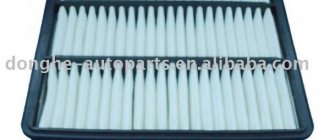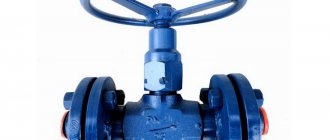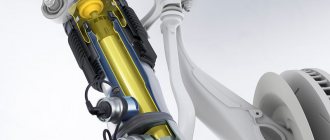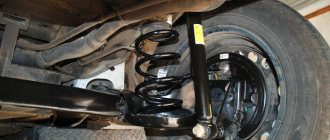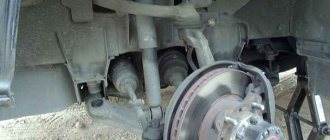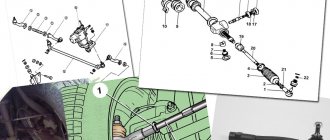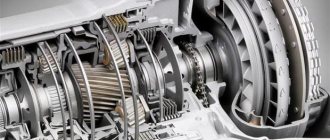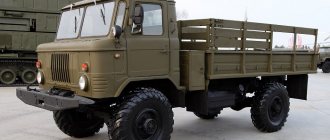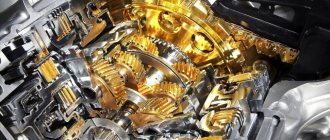Features of the unit and design
Cars use a kinematic method of changing the direction of movement, implying that turning occurs by changing the position of the steered wheels. Usually the front axle is steered, although there are also cars with a so-called steering system. The peculiarity of working in such cars is that the wheels of the rear axle also turn when changing direction, albeit at a smaller angle. But so far this system has not received widespread use.
In addition to the kinematic method, the technique also uses the power method. Its peculiarity is that to make a turn, the wheels on one side slow down, while on the other side they continue to move at the same speed. And although this method of changing direction has not become widespread in passenger cars, it is still used on them, but in a slightly different capacity - as a directional stability system.
This car assembly consists of three main elements:
- steering column;
- steering gear;
- drive (system of rods and levers);
Steering unit
Each component has its own task.
The design of the power steering of a MAZ car
1 - hydraulic cylinder; 2 — rod; 3 - discharge pipeline; 4 - piston; 5, 31 and 32 - plugs; 6— ball joint housing; 7 — adjusting nut of the ball joint clearance of the longitudinal rod; 8 — pusher; 9 — ball pin of the longitudinal steering rod; 10 — bipod ball pin; 11 - drain pipeline; 12 - cover; 13 — distributor housing; 14 - flange; 15 and 17 - pipelines; 16 — seal fastening clamp; 18 — oiler; 19— cracker; 20 — locking screw; 21 — hydraulic cylinder cover; 22— screw; 23— inner washer for securing the cover; 24 — rod head; 25 — cotter pin; 26 — drain pipe fitting; 27—discharge pipe fitting; 28 — hose holder; 29 — adjusting plug for the bipod ball joint clearance; 30 - spool; 33 - coupling bolt; 34 — connecting channel; 35 — glass; 36 - check valve.
The liquid supplied by the pump through the discharge line to the distributor fills the two outer annular cavities and, in the straight-line movement of the car, passing between the edges of the spool into the central annular cavity, returns through the pipeline to the pump reservoir. When the steering wheel is turned, the ball pin of the bipod moves the spool away from the neutral (middle) position. As a result, the outer and central annular cavities are separated by the flange of the spool and the liquid is pumped into one of the cavities of the power cylinder, and from the other is drained into the tank. Under the influence of fluid pressure, the power cylinder moves the ball pin of the longitudinal steering rod and the entire spool mechanism. Through the channels in the spool, fluid under pressure is always transferred to the reaction chambers, so the spool tends to return to the neutral position.
Steering column
Transmits the rotational force that the driver creates to change direction. It consists of a steering wheel located in the cabin (the driver acts on it, rotating it). It is firmly mounted on the column shaft. The design of this part of the steering very often uses a shaft divided into several parts connected to each other by cardan joints.
This design was made for a reason. Firstly, this allows you to change the angle of the steering wheel relative to the mechanism, shifting it in a certain direction, which is often necessary when assembling the components of a car. In addition, this design makes it possible to increase the comfort of the cabin - the driver can change the position of the steering wheel in terms of reach and tilt, ensuring its most comfortable position.
Secondly, the composite steering column tends to “break” in the event of an accident, reducing the likelihood of injury to the driver. The bottom line is this: during a frontal impact, the engine can move back and push the steering mechanism. If the column shaft were solid, changing the position of the mechanism would lead to the shaft with the steering wheel exiting into the cabin. In the case of a composite column, the movement of the mechanism will only be accompanied by a change in the angle of one component of the shaft relative to the second, and the column itself remains stationary.
Basic design
The steering device of any type of car has common features that are reflected in its design. Regardless of the brand, type and purpose, the steering system consists of:
- The steering wheel, with the help of which the driver directly controls the system and sets the desired direction of movement. It is often equipped with signal buttons, multimedia system control buttons, and an airbag can be built into it.
- The steering column or shaft that transmits force from the steering wheel to the elements of the steering mechanism. Most often it is a shaft with a hinged or cardan joint, with special locking elements. The ignition switch is located near the steering column.
- A steering mechanism that converts steering wheel rotation into wheel drive rotation. This is a gearbox with a given gear ratio. To increase efficiency it can be equipped with an amplifier.
- A steering drive that transmits a given force directly to the steering knuckles of the wheels.
To increase driver comfort, the steering can be equipped with additional shock absorbers, electronic, hydraulic and other systems.
Steering gear
Designed to convert the rotation of the steering column shaft into translational movements of the drive elements.
The most common mechanisms in passenger cars are the “gear-rack” type. Previously, another type was used - a “worm-roller”, which is now mainly used on trucks. Another option for trucks is “screw-type”.
"rack and pinion"
The rack and pinion type became widespread due to the relatively simple design of the steering mechanism. This structural unit consists of three main elements - a housing in which the gear is located and a rack perpendicular to it. Between the last two elements there is a constant gearing.
This type of mechanism works like this: the gear is rigidly connected to the steering column, so it rotates along with the shaft. Due to the gear connection, rotation is transmitted to the rack, which, under such influence, moves inside the housing in one direction or another. If the driver turns the steering wheel to the left, the interaction of the gear with the rack causes the latter to move to the right.
Often, cars use rack-and-pinion mechanisms with a fixed gear ratio, that is, the range of rotation of the steering wheel to change the angle of the wheels is the same in all their positions. For example, let's assume that to turn the wheels at an angle of 15°, you need to make 1 full revolution of the steering wheel. So, it doesn’t matter what position the steered wheels are in (extreme, straight), to turn by the specified angle you will have to make 1 revolution.
But some automakers install mechanisms with variable gear ratios on their cars. Moreover, this is achieved quite simply - by changing the angle of the teeth on the rack in certain areas. The effect of this modification of the mechanism is as follows: if the wheels are straight, then 1 revolution is required to change their position by the same 15° (example). But if they are in the extreme position, then due to the changed gear ratio, the wheels will turn to the specified angle after half a turn. As a result, the wheel's edge-to-edge steering range is significantly less than with a fixed-ratio mechanism.
Variable ratio rack
In addition to the simplicity of the device, the rack-and-pinion type is used also because in such a design it is possible to implement the actuators of the hydraulic booster (GUR) and electric power steering (EUR), as well as electro-hydraulic (EGUR).
"worm-roller"
The next type, the “worm-roller”, is less common and is now practically not used on passenger cars, although it can be found on VAZ cars of the classic family.
This mechanism is based on a worm gear. A worm is a screw with a special profile thread. This screw is located on a shaft connected to the steering column.
In contact with the thread of this worm is a roller connected to a shaft on which a bipod is mounted - a lever that interacts with the drive elements.
Worm steering gear
The essence of the mechanism is as follows: when the shaft rotates, the screw rotates, which leads to longitudinal movement of the roller along its thread. And since the roller is mounted on the shaft, this displacement is accompanied by rotation of the latter around its axis. This in turn leads to a semicircular movement of the bipod, which affects the drive.
The “worm-roller” type mechanism on passenger cars was abandoned in favor of the “rack and pinion” due to the impossibility of integrating a hydraulic booster into it (trucks still had it, but the actuator was remote), as well as the rather complex design of the drive.
Screw type
The design of the screw mechanism is even more complex. It also has a threaded screw, but it does not contact the roller, but a special nut, on the outer side of which there is a toothed sector that interacts with the same one, but made on the bipod shaft. There are also mechanisms with intermediate rollers between the nut and the gear sector. The principle of operation of such a mechanism is almost identical to the worm mechanism - as a result of interaction, the shaft rotates and pulls the bipod, and that in turn, the drive.
Helical steering mechanism
A hydraulic booster can be installed on the screw mechanism (the nut acts as a piston), but it is not used on passenger cars due to the massive structure, which is why it is used only on trucks.
Steering classification
There are no fundamental differences between different types of steering, but it is often classified according to the type of steering gear:
Rack and pinion gear type.
Steering device with a gear-rack type gearbox 1 - steering wheel; 2 — steering shaft with gear; 3 - rack; 4 — steering rods; 5 — rotary levers; 6 - wheels.
This is the most common type of steering gear, which has proven its reliability over the years of use.
The principle of operation is very simple: an oblong gear is attached to the steering shaft (which extends from the steering column). The steering rack has a toothed section that meshes with this gear. When the steering wheel rotates, the gear rotates in place and pushes the rack in one direction or the other. Accordingly, the steering rods also come into action.
Drive unit
The drive in the steering design is used to transmit the movement of the rack or bipod to the steered wheels. Moreover, the task of this component is to change the position of the wheels at different angles. This is due to the fact that the wheels move along different radii when turning. Therefore, when changing the trajectory of movement, the wheel on the inside must turn at a larger angle than the outside.
The design of the drive depends on the mechanism used. So, if a car uses a “rack and pinion”, then the drive consists of only two rods connected to the steering knuckle (the role of which is played by the shock absorber strut) via a ball end.
These rods can be attached to the rail in two ways. Less common is their rigid fixation with a bolted connection (in some cases the connection is made through a silent block). For such a connection, a longitudinal window is made in the mechanism body.
A more common method of connecting rods is a rigid but movable connection to the ends of the rail. To ensure such a connection, a ball tip is made at the end of both rods. By means of a nut, this ball is pressed against the rail. When the latter moves, the rod changes its position, which ensures the existing connection.
In drives that use a worm-roller mechanism, the design is much more complex and consists of a whole system of levers and rods, called a steering linkage. So, for example, on the VAZ-2101 the drive consists of two side rods, one middle rod, a pendulum arm and steering knuckles with levers. At the same time, to ensure the possibility of changing the angle of the wheel position, the steering knuckle is attached to the suspension arms using two ball joints (upper and lower).
A large number of component elements, as well as connections between them, makes this type of drive more susceptible to wear and backlash. This fact is another reason for abandoning the worm gear in favor of a rack and pinion mechanism.
Steering - design and principle of operation
The general structure and operating principle of the steering system of a car, like many other modern vehicles, can be described as follows. The steering system has tie rods, a rack-and-pinion or worm-gear steering mechanism, and a steering column that ends in a steering wheel. The system functions quite simply: when the steering wheel is applied, the force is transmitted through the steering mechanism to the steering rods, which are pivotally connected to the suspension arms, which leads to a change in the trajectory of the car. In addition, the steering wheel informs the driver about the condition of the road surface, determined by the amount of force applied to the steering wheel. If you do not take into account the size of the steering wheel of sports cars, the diameter of the steering wheel for most cars is in the range of 38-42.5 cm.
The steering wheel is connected to the steering mechanism via a safety steering column, which has several cardan joints. Injury safety lies in the fact that in the event of a frontal collision at high speed, it (the column) folds, thus reducing the severity of injuries inflicted on the driver. Modern cars are equipped with electrical or mechanical adjustment to adapt the steering column to the height of the driver. The change is carried out both in the vertical direction and along the length, or in two directions. Anti-theft protection is also provided by locking the steering column electrically or mechanically.
The steering mechanism acts as a multiplier of the forces applied by the driver to the steering wheel with the subsequent distribution of the load on the steering drive. The most used type of steering gear in cars is the worm and rack and pinion design, and the first option was more often used in cars of the last century. The rack and pinion version is a cylindrical gear that is integral with the shaft and moves along a rack, which is pivotally connected to the steering rods. When the position of the steering wheel changes to a certain angle, the rack moves in a horizontal plane and turns the wheels through rods. The gear-rack pair is located in the gearbox housing, which is located in the suspension subframe.
Some cars are equipped with a steering mechanism with a variable gear ratio, where a gear rack with a different tooth profile is used: in the near-zero zone the teeth have the shape of a triangle, and closer to the edges they have the shape of a trapezoid. The design of the rack with different tooth geometries helps to change the gear ratio in the gear-rack pair, reducing the angle of rotation of the steering wheel. Thanks to this scheme, driving a car is much more convenient, more dynamic, and less effort is required on the steering wheel.
Some car manufacturers use four-wheel steering mechanisms on their cars. The design allows for more efficient control and ensures machine stability when driving at high speeds. Thanks to this technical solution, the front and rear wheels of the car are synchronized when turning in one direction or another. In addition, maneuverability has been improved when the car is moving at low speed: the front and rear wheels can be turned in different directions. This is achieved due to the fact that at high vehicle speeds, the silent blocks installed on the rear suspension are deformed under the influence of forces during the car's turn, preventing the wheels from significantly changing the angle of rotation.
The steering drive is a hinge-lever structure, through which the forces applied to the steering wheel are transmitted directly to the wheels, while ensuring vehicle stability when turning. In addition, the structure holds the wheels while the suspension is operating, the type of which depends on the steering drive device.
The most popular mechanical design of the steering gear includes steering rods and ball joints (steering joints). In turn, the ball joint, protected from wear by liners, is located in a housing with a closed rubber boot, which prevents dust and dirt from penetrating into the joint. The ball joint is made as one piece with a ball pin, which serves as a tip for the steering rods and forms an additional suspension arm with them.
To adjust the steering, there are several parameters that affect the stability of the car while driving and the force applied to the steering wheel. The four most important of them relate to angular adjustments: camber, toe, caster and lateral inclination of the wheel hub, as well as two shoulder adjustments (stabilization and running-in). It is worth noting that all adjustments are interconnected and have an important impact on the operation of the entire steering system.
Modern cars can no longer do without power steering, which significantly reduces the force applied to the steering wheel and allows you to accurately and quickly respond to the environment when driving. Thanks to power steering, the driver is less tired, and the gear ratio in the gearbox can be reduced, making it more compact. By type, the amplifier drive is divided into electric, hydraulic or pneumatic. The latter is more related to trucks.
Most of the current generation of cars are equipped with hydraulic power steering, called “power steering” for simplicity. In addition, there is a variant of it - an electro-hydraulic booster, in which the liquid is pumped by a pump driven by an electric motor. However, the electric power steering used today is considered progressive, in which the torque of the electric motor shaft is supplied directly to the steering wheel driveshaft or directly to the steering gearbox. And the use of electronics makes it possible to use an electric booster when parking in automatic mode or in a system that helps keep the car in the lane.
Adaptive power steering can be considered an innovative power steering, thanks to which the force applied when turning the wheel depends on the speed of movement. An example of such a design is the well-known adaptive hydraulic booster Servotronic. New items include BMW's active steering system, as well as Audi's dynamic steering system, in which the steering gear ratio depends on the vehicle's speed.
"Feedback"
It is worth noting that there is also a so-called “feedback” in the steering mechanism. The driver not only acts on the wheels, but through it also receives information about the characteristics of the movement of the wheels on the road. This manifests itself in the form of vibrations, jerks, and the creation of clearly directed forces on the steering wheel. This information is considered very important for correctly assessing the behavior of the car. Proof of this is the fact that in cars equipped with power steering and electric steering, the designers retained “feedback”.
Main causes of malfunction
The vehicle control system, like all its mechanisms, is susceptible to breakdowns.
Recommended: Minimum brake pad thickness
In most cases, they can be predicted in advance due to the presence of previous symptoms.
The system can be damaged by adverse events, such as:
- improper operation of the vehicle, expressed in an aggressive driving style;
- poor quality road surface, presence of potholes and uneven surfaces;
- installation of non-original spare parts during the replacement procedure;
- incompetent repair work;
- untimely service;
- Exceeding the service life of the equipment.
Problems that arise with the vehicle control system while the vehicle is moving can cause accidents. Therefore, you should listen to signs that are harbingers of trouble.
Advanced Developments
This unit continues to be improved, so the latest achievements are the following systems:
- Active (dynamic) steering. It allows you to change the gear ratio of the mechanism depending on the speed of the car. It also performs an additional function - adjusting the angle of the front wheels when cornering and when braking on slippery roads.
- Adaptive steering (steering by wire). This is the newest and most promising system. There is no direct connection between the steering wheel and the wheels; everything works due to sensors and actuators (servos). The system has not yet become widespread due to psychological and economic factors.
Steering-by-wire system
Car steering requirements
The steering of any vehicle must meet the following requirements:
- Ensure sufficient maneuverability of the vehicle at any speed. The driver should be able to easily set the desired direction of the car;
- It should be easy to use, so that even a tired driver can safely reach their resting place;
- When turning the wheels, the steering must provide the cleanest rolling possible. When cornering, the wheels should not slip so that the car does not lose its stability. To do this, the angle of inclination and rotation of the wheels must be clearly adjusted;
- Return the wheels back to a straight line (along the body) after the driver stops making efforts to turn;
- Dampen vibrations when driving on uneven road surfaces;
- Be highly responsive to any driver commands;
- Even if the amplifiers fail, the mechanism should still allow the driver to control the car.
Another parameter that falls under the steering requirements category is steering play. More information about permissible backlash standards is described in a separate article .
The role of the amplifier in the steering system
This element, in addition to reducing the force applied by the driver to the steering wheel, can significantly increase the accuracy of driving. Thanks to the presence of an amplifier in the steering design, it became possible to use elements in the system that have a small subordinate number. Control amplifiers are divided into three types:
- Electric.
- Pneumatic.
- Hydraulic.
However, the latter type has become more widespread. Hydraulics are distinguished by their reliable design and smooth operation, but require maintenance to replace the fluid. Electric power steering is less common, but most models of modern automobiles are equipped with it. Reinforcement is provided by an electric drive. Note that electronic control is distinguished by the presence of an expanded range of capabilities, but occasionally requires checking and adjustment.
Steering rack device
This is a simple mechanism that has the following components:
- The steering wheel, which is located in the cockpit. Used to set the vehicle's direction of travel.
- Steering shaft. This is a metal rod that is equipped with special grooves. They are called splines. With their help, the steering wheel is attached on one side, and on the other, it is attached to the steering column.
- When creating a rack, a gear and the rack itself are used. A special lightweight alloy of increased strength is used in production.
- Tie rods are metal rods that have threads on one side and a threaded joint on the other.
- The steering tip is equipped with a threaded joint.
These are all components of the steering rack. True, it can also include a damper. This is a two-way shock absorber. Its purpose is to reduce vibration while driving. Thus, it is possible to reduce the negative impact on the entire mechanism. Not all cars have it, but SUVs have it installed by default. This is due to the fact that these cars often travel on bad roads.
steering rack with power steering
